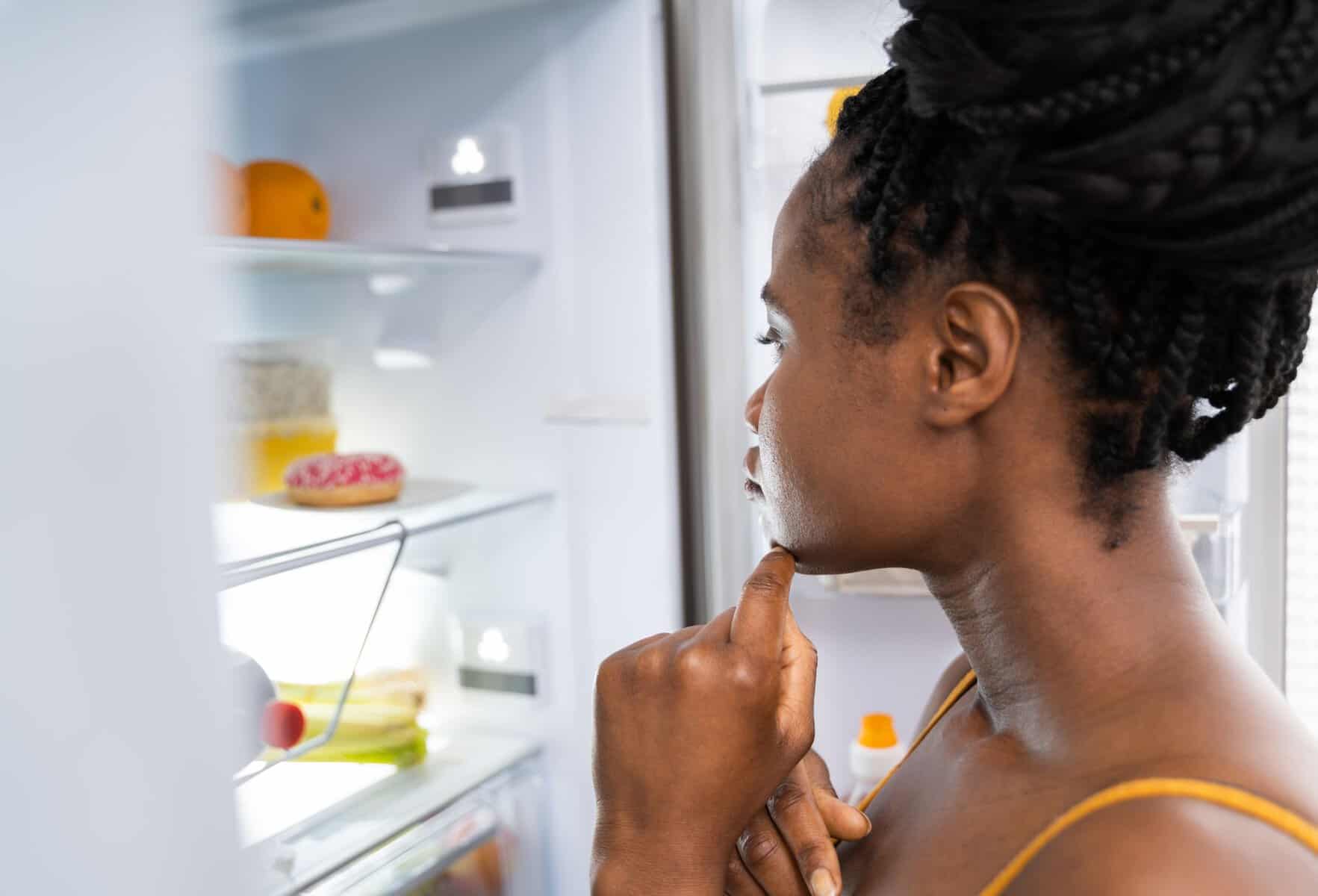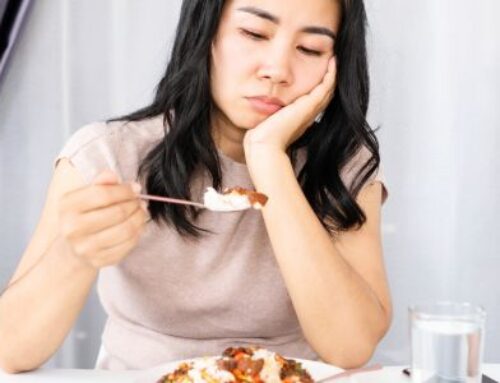
I would be lying if I told you that I have never stood in front of the fridge, looking for something to eat, moments after eating dinner. On occasion it’s because I’m still hungry, but other times the reason is less clear.
When it comes to eating, there are two main causes: physical hunger and head hunger. Our response is the same (seek food and eat food), but they are very different drivers. So, which is leading you to the pantry/fridge?
Physical Hunger
When it comes to physical hunger, a growling stomach is not the only way to decide whether you are hungry. Hunger sits on a spectrum, where we can go from ‘ravenous’ to ‘overly full’. Generally, we sit somewhere in the middle (slightly hungry to satisfied). It therefore makes sense that hunger is felt in different ways. ‘Hangry’ is how I describe myself if I have waited too long to eat. Others experience brain fog, lethargy, and nausea. As hunger creeps up, you might go from feeling empty to physically ill.
Regardless, the only way to ‘cure’ physical hunger is by eating. If you notice that it is true hunger causing you to head to the pantry after dinner, check out my article on nighttime eating. But if it isn’t physical hunger, read on.
Head Hunger
Unlike physical hunger, head hunger is a response to your environment or feelings.
It usually appears suddenly, with a craving for something specific (often sweet or salty). Because it appears suddenly, head hunger leads us to believe that we need to eat it at once to gain satisfaction (no waiting for ad breaks). However, once we start eating it, we often do so mindlessly, eating more than we normally would and end up feeling unsatisfied (and guilty too).
Head hunger can feel frustrating but know that there is generally a trigger. So, let’s find yours.
Habit
Have you ever done something, only to not remember if you did it? Locking the front door for instance. When a routine becomes so ingrained it becomes a habit, one that our body does on autopilot. Unfortunately, eating can become a habit.
All habits (good or bad) are built through learning and repetition, through a ‘habit loop’. First, we have a cue that tells your brain to go on autopilot as the routine is about to begin. Then there is the routine itself and all the actions you take to complete it. And finally, there is the reward, something that your brain likes, that helps it remember the loop for the future.
So, how does this relate to eating more at night? Well, we are creatures of habit. Whether you know it now or not, your environment may act as the cue leading you to eat on autopilot at night. Examples of habit induced eating include:
- Grabbing an ice cream after putting the children to bed.
- Eating popcorn while watching a late-night movie.
- Munching on chips while watching TV.
Each of the examples has a cue that triggers the action, with food being the reward. Do you have a cue that is triggering your eating at night?
Because It’s There
So, you aren’t the one responsible for grabbing the family sized chips to watch TV. But did you eat them anyway? ‘I just can’t help myself’, is not an excuse, but a universal truth (according to science)! If presented with food, we will eat it.
Wansink investigated this phenomenon using movie-goers. Attendees were given either a medium or large bucket of popcorn. Those given a large bucket at 43.5% more popcorn than those with a medium bucket. The size of the bucket was so powerful that even those that were given a large bucket of stale popcorn, ate 33.5% more than those with a medium bucket of stale popcorn. This research was later reframed at a Chinese buffets and takeaway meals with similar results.
Therefore, it appears that if food is in front of us (particularly in a large container), we will eat it, just because it’s there.
Emotions
When you use food to deal with your feelings instead of to satisfy hunger, we call it ‘emotional eating’.
Turning to food for comfort and getting rewarded with good sensations works in the short-term, but does not address the underlying issue (stress, anxiety, loneliness, fatigue, etc.). Instead, we can feel worse with an uncomfortably full belly.
It is natural to have an emotional connection to food. The goal is to allow yourself to make a conscious decision about when, what, and how much you eat, as well as affording you the opportunity to address the actual underlying emotion. There will be times when it makes sense for food to be part of dealing with big emotions, but for other times, there are more effective ways to cope.
What Can I Do?
Identify if you are hungry
Gauge your appetite:
- How hungry am I?
- Has my hunger developed slowly or appeared suddenly?
- Was my last meal satisfying?
- Am I looking for something particular to eat or will anything do?
If you are physically hungry, eat! If not, keep investigating.
Identify your trigger
Investigate the cause:
- Where are you?
- How do you feel?
- Who are you with?
- What have you been doing?
- If you did eat, how do you feel after eating? Satisfied?
It can take a couple of days to find a pattern. Keeping a ‘Food & Mood Journal’ can be a good way to keep your thoughts clear.
Find Non-Food Rewards
Instead of rewarding yourself with food, find something else you enjoy. Meditation, knitting, walking, journaling, relaxing in the bath.
Practice Mindfulness
If you do still want to treat yourself with food, own it! Take the time to put an amount you would be happy with on a nice plate and put the rest away. Eat each bite with enjoyment. Still feel like more? Repeat.
Looking for snack inspiration? Check these out.
Seek Support
Not confident you can do it alone? Let us help! We are trained to help you build a better relationship with food.
Make an appointment with a dietitian today to start your journey towards building a better relationship with food.
References
Chaput, J. P., & St-Onge, M. P. (2014). Increased food intake by insufficient sleep in humans: Are we jumping the gun on the hormonal explanation? Frontiers in Endocrinology, 5(JUL), 116. https://doi.org/10.3389/FENDO.2014.00116/BIBTEX
Colino, S. (2021, September 22). How to avoid decision fatigue. The Washington Post. https://www.washingtonpost.com/lifestyle/wellness/too-many-choices-decision-fatigue/2021/09/21/2dffce74-1b22-11ec-bcb8-0cb135811007_story.html
Crispim, C. A., Zimberg, I. Z., Gomes Dos Reis, B., Diniz, R. M., Tufik, S., & Túlio De Mello, M. (2011). Relationship between Food Intake and Sleep Pattern in Healthy Individuals. Journal of Clinical Sleep Medicine : JCSM : Official Publication of the American Academy of Sleep Medicine, 7(6), 659. https://doi.org/10.5664/JCSM.1476
Greer, S. M., Goldstein, A. N., & Walker, M. P. (2013). The impact of sleep deprivation on food desire in the human brain. Nature Communications, 4, 2259. https://doi.org/10.1038/NCOMMS3259
Hamidi, M. S., Shanafelt, T. D., Hausel, A., Bohman, B. D., Roberts, R., & Trockel, M. T. (2019). Associations Between Dietary Patterns and Sleep-Related Impairment in a Cohort of Community Physicians: A Cross-sectional Study. Https://Doi.Org/10.1177/1559827619871923. https://doi.org/10.1177/1559827619871923
Krishna, A., & Hagen, L. (2019). Out of proportion? The role of leftovers in eating-related affect and behavior. Journal of Experimental Social Psychology, 81, 15–26. https://doi.org/https://doi.org/10.1016/j.jesp.2018.08.005
Marchiori, D., Corneille, O., & Klein, O. (2012). Container size influences snack food intake independently of portion size. Appetite, 58(3), 814–817. https://doi.org/10.1016/J.APPET.2012.01.015
Northup, T., & Valenti, J. J. (2014). Understanding the Relationship Between Television Use and Unhealthy Eating: The Mediating Role of Fatalistic Views of Eating Well and Nutritional Knowledge. The International Journal of Communication and Health, 3, 10–15.
Pilcher, J. J., Morris, D. M., Donnelly, J., & Feigl, H. B. (2015). Interactions between sleep habits and self-control. Frontiers in Human Neuroscience, 9(MAY), 284. https://doi.org/10.3389/FNHUM.2015.00284
Psychology Today. (2022). Habit Formation. Psychology Today. https://www.psychologytoday.com/au/basics/habit-formation
Wansink, B., & Kim, J. (2005). Bad popcorn in big buckets: portion size can influence intake as much as taste. Journal of Nutrition Education and Behavior, 37(5), 242–245. https://doi.org/10.1016/S1499-4046(06)60278-9
Wansink, B., & van Ittersum, K. (2013). Portion size me: Plate-size induced consumption norms and win-win solutions for reducing food intake and waste. Journal of Experimental Psychology: Applied, 19(4), 320–332. https://doi.org/10.1037/A0035053
Ward, A. L., Galland, B. C., Haszard, J. J., Meredith-Jones, K., Morrison, S., McIntosh, D. R., Jackson, R., Beebe, D. W., Fangupo, L., Richards, R., Te Morenga, L., Smith, C., Elder, D. E., & Taylor, R. W. (2019). The effect of mild sleep deprivation on diet and eating behaviour in children: Protocol for the Daily Rest, Eating, and Activity Monitoring (DREAM) randomized cross-over trial. BMC Public Health, 19(1), 1–13. https://doi.org/10.1186/S12889-019-7628-X/FIGURES/3
Young, L. R., & Nestle, M. (2003). Expanding portion sizes in the US marketplace: Implications for nutrition counseling. Journal of the American Dietetic Association, 103(2), 231–240. https://doi.org/https://doi.org/10.1053/jada.2003.50027



